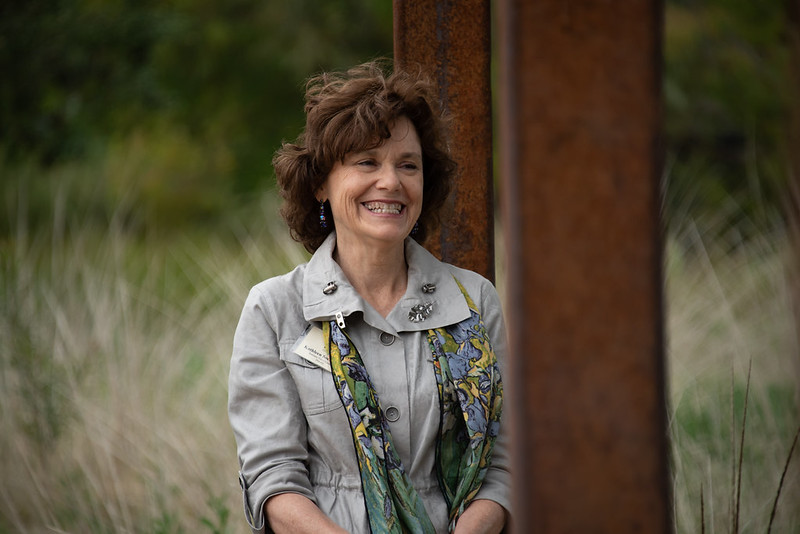
Thanks a Million! Celebrating the Legacy and Retirement of Kathleen Socolofsky

Honor Kathleen’s Legacy
Celebrate Kathleen Socolofsky’s 27 years of transformative leadership by considering a gift to the Kathleen Socolofsky Learning by Leading and Community Engagement Endowment, established by Barbara and Paul Schneeman. Your gift will help ensure the programs she championed—like Learning by Leading™—continue to grow and inspire future leaders.
After more than a quarter century of visionary leadership at UC Davis, Kathleen Socolofsky, assistant vice chancellor and director of the UC Davis Arboretum and Public Garden, is retiring—leaving behind not only a transformed campus landscape, but a reimagined way of thinking about the role gardens and landscapes can play in academic life, student development, and community connection.
From Campus Jewel to National Model
Under Kathleen’s leadership, what began as a beloved campus destination—the 100-plus acre UC Davis Arboretum, affectionately known as the “jewel of the campus”—has grown into a nationally recognized model for environmental leadership and innovation in public garden management. Featuring scientific collections, sustainable demonstration gardens, and welcoming community spaces, the Arboretum became the foundation for something larger.
Connected to University Mission and Operations
In 2011, UC Davis formally brought together the Arboretum, Grounds and Landscape Services, and the Putah Creek Riparian Reserve to form the UC Davis Arboretum and Public Garden. Kathleen was asked to lead this new, integrated unit. For the first time, the entire 5,300-acre campus landscape—from teaching gardens to natural reserves—was able to be managed as a unified, mission-driven whole.
This shift enabled a holistic approach to stewardship. Under Kathleen’s leadership, UC Davis embraced its outdoor spaces not just as scenery, but as a vital extension of its mission.
In November 2023, the Arboretum and Public Garden officially became part of UC Davis Facilities Management, reinforcing its connection to campus stewardship.
“Kathleen has built an incredible team and a culture that’s admired across campus,” said Clint Lord, associate vice chancellor of Facilities Management.
“We will continue to support and strengthen the values and practices that Kathleen established. Her leadership has set a high standard, and we’re committed to building on that foundation.”
Kathleen also had a dotted-line reporting relationship to the Office of the Provost, reflecting the Arboretum and Public Garden’s integral role in the university's academic and research endeavors. This connection has ensured that the organization's initiatives align with the broader educational mission of UC Davis.
“Kathleen has redefined what a university landscape can be,” said Mary Croughan, provost and executive vice chancellor. “Through her vision and leadership, she transformed our campus into one that connects students, faculty, and the public with real-world learning, environmental stewardship, and one another.”
Catalyst for Community Engagement
When Kathleen stepped into her role 27 years ago, the Arboretum already held a cherished place in the hearts of many on campus and in the community. Building on that foundation, she helped introduce expanded interpretive signage and programs, launched the UC Davis GATEways Project (GATE stands for Gardens, Arts and The Environment) to strengthen connections between the university and the public, established the one-acre Arboretum Teaching Nursery, and began revitalizing the Arboretum Waterway into the vibrant, climate-ready ecosystem it is evolving into today.
Over time, Kathleen helped shift the campus perspective—demonstrating that our outdoor spaces could be more than beautiful. They could serve as living classrooms, spaces for student leadership and discovery, and places of community connection and well-being.
Those who’ve worked with Kathleen know her style is… distinct. Her sketches have a bit of a reputation—abstract, unexpected, and met with a raised eyebrow, or two. They are more about big-picture thinking than real-world places. But give it a minute—and a few conversations—and that quirky diagram starts to click.
And, when it does, it’s clear: her ideas don’t stay on paper.
Kathleen’s impact is visible not only in the beauty of UC Davis’ landscapes but in the inclusive, intentional way they came to life. Whether reimagining how a pathway shapes a visitor’s experience or incorporating ideas from students, faculty, artists, and community partners, she ensured every space was designed with purpose and care.
The Native American Contemplative Garden exemplifies this approach. Created in close collaboration with Patwin community members and Native American Studies faculty as part of the UC Davis Project to Honor Native Americans, the space is more than a garden—it is a living acknowledgment of the land’s original stewards. Designed to invite reflection, healing, and cultural respect, it weaves together traditional knowledge, native plants, and thoughtful design elements that honor the connection between people and place. From its earliest planning stages, the project was guided by relationship-building, cultural exchange, and a deep commitment to creating a space that is as meaningful as it is beautiful.
That same commitment to multi-layered, collaborative design is evident in the transformation of the Health Sciences District. Once a stretch of bare, undeveloped land surrounding the world’s top-ranked veterinary school, it is now a thriving, climate-resilient landscape. The Hummingbird GATEway Garden, shaped through partnerships with Campus Planning, Transportation Services, the School of Veterinary Medicine, and others, supports academic research and features bioswales that capture stormwater, drought-tolerant demonstration gardens, wildlife habitats, green parking innovations, and more—all enriched by contributions from students, faculty, volunteers, and community members.
These are just two examples of many that reflect Kathleen’s belief that meaningful environments begin with a shared vision. She approaches every initiative not as a top-down directive but as a collaborative journey—one that prioritizes engagement, inclusivity, and community ownership.
Growing People and Gardens
“Kathleen doesn’t just ask for your support—she brings you into a vision that feels both personal and powerful,” said Dr. Ernie Lewis, donor and board member of the EXCELerate Foundation. “She helps you see the bigger picture and understand how your involvement truly makes a difference. That’s why people show up.”
From the start of her tenure, Kathleen fostered an organizational culture grounded in collaboration and strengths-based leadership. Early on, she led the Arboretum through the Drucker Foundation Self-Assessment Process, gathering input from more than 4,000 campus and community members. That feedback shaped a long-range vision and helped build the inclusive, forward-looking team that drives the Arboretum and Public Garden today.
Her deep understanding of what people need from nature became especially clear during the COVID-19 pandemic. As many public spaces closed, Kathleen ensured that the Arboretum remained open. She recognized it as more than a scenic path—it was a refuge, a source of well-being, and a safe place to be with others. Her leadership helped the campus and community find calm and connection in a time of uncertainty.
Learning by Leading: A Lasting Legacy
That same belief in the power of people and place inspired one of UC Davis’s most transformative programs: Learning by Leading™. Based on the idea that students grow through hands-on leadership experience, the program emphasizes mentorship while giving students real responsibility. Since its launch, over 1,000 students have developed leadership and environmental stewardship skills, and the model has expanded across North America through a thriving Community of Practice that Kathleen helped establish.
To ensure this legacy lives on, Barbara Schneeman, former dean of the College of Agricultural and Environmental Sciences, and her husband Paul generously established the Kathleen Socolofsky Learning by Leading and Community Engagement Endowment.
“We established the Kathleen Socolofsky Endowment to support the Arboretum and Public Garden’s role in campus academic programs and community engagement,” they shared.
“Programs such as the Learning by Leading student internships enhance UC Davis academic programs by developing students’ skills for environmental leadership and serve as a model for other universities. Support of the endowment will allow these programs to continue and grow.”
Kathleen’s work has left a lasting mark on UC Davis and influenced public gardens nationwide. From helping develop the UC Davis Living Landscape Adaptation Plan—a climate-ready roadmap for managing our campus landscape for the next 70+ years—to sharing models and ideas with public gardens across the country, she redefined what it means to steward a university landscape in the 21st century.
“She didn’t just make UC Davis more beautiful,” said Bob Segar, associate vice chancellor emeritus. “She changed the way we think about the landscape—as a space to learn, to heal, to lead, and to connect.”
As she retires, the campus she leaves is more resilient, more welcoming, and more alive—not just because of the gardens she helped grow, but because of the people she empowered to keep growing them.
Passing the Torch
Kathleen not only expanded the impact of the Arboretum and Public Garden—she also made it a priority to cultivate the next generation of leadership to carry its momentum forward. She worked closely with campus leaders to develop a thoughtful succession plan– ultimately leading to the appointment of Carmia Feldman, who served as Assistant Director since 2006, as the new director. Kathleen is thrilled with the decision and confident in Carmia’s experience, dedication, and deep understanding of the organization. Carmia, in turn, is honored to continue Kathleen’s legacy of inclusive leadership, community engagement, and strong collaboration with campus and community partners. (Learn more about Carmia's selection.)
Thank you, Kathleen. You didn’t just help create a beautiful resource for the students and community at one of the world’s leading universities—you championed a way of working that made room for multiple wins. You believed that when we work together, all ships can rise. You have a gift for getting people talking, thinking, and moving in the same direction. You built bridges across departments, disciplines, and communities, helping us see what’s possible when purpose is shared. Your sketches and plans were never about dictating the outcome—they were about sparking energy, opening doors, and inviting others in. Because of you, we’re not just left with a legacy—we have a strong foundation, real momentum, and a clear path to keep building on what you started. And for that, we are all forever grateful.
